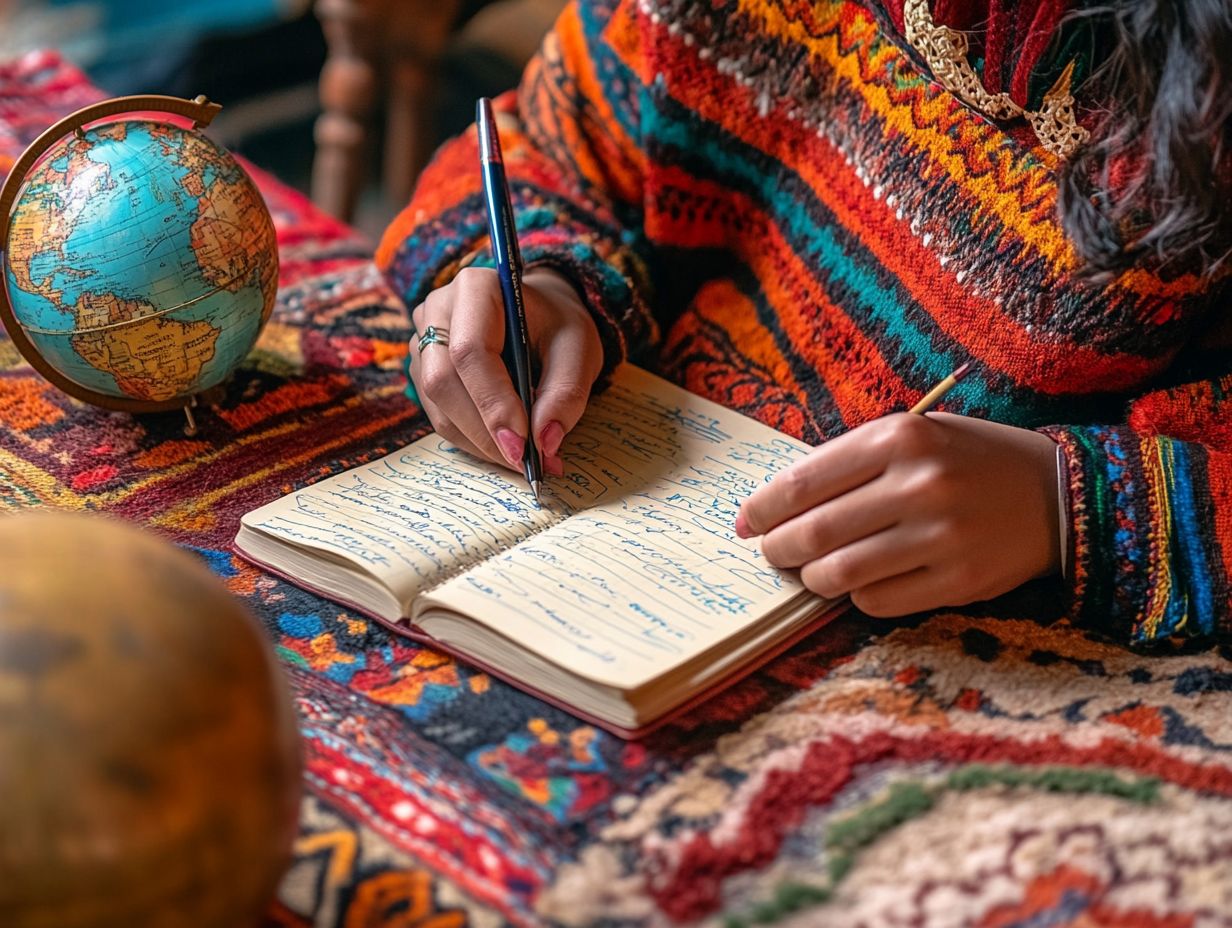How to Write About Your Cultural Adjustment Experience
Cultural adjustment can be challenging. It can also be a transformative experience. When you share your experiences, you spark growth in yourself and others!
This article explores the importance of recounting your cultural adjustment story. It offers guidance on preparing to write it. You ll find tips for authentic storytelling and advice on connecting with the right audience.
Join in uncovering the power of your voice as a means to bridge cultural divides.
Contents
- Key Takeaways:
- The Importance of Sharing Cultural Adjustment Experiences
- Preparing to Write About Your Experience
- Structuring Your Story
- Tips for Writing Authentically
- Sharing Your Story with Others
- Frequently Asked Questions
- What is cultural adjustment?
- Why is it important to write about your cultural adjustment experience?
- How should I start writing about my cultural adjustment experience?
- What should I include in my writing about cultural adjustment?
- How can I make my writing about cultural adjustment more impactful?
- Do I need a specific writing style when writing about cultural adjustment?
Key Takeaways:

- Share your cultural adjustment experience to promote understanding.
- Reflect on your journey before writing to convey your story effectively.
- Use emotions and avoid stereotypes to foster meaningful discussions.
The Importance of Sharing Cultural Adjustment Experiences
Sharing your cultural adjustment experiences is essential. It deepens your understanding of the emotional journey you navigate while facing contrasts between your home culture and the new environment around you.
For those moving from Kazakhstan to the United States, this journey can be filled with challenges. You may experience culture shock, which is the feeling of confusion when facing a different culture. Adapting to unfamiliar customs, social norms, and communication dynamics that define American culture can be daunting.
By sharing these experiences, you foster empathy. You support one another in your cultural immersion and enrich the collective narrative of cultural identity.
Benefits for Yourself and Others
Sharing your cultural adjustment journey helps you process your emotional ups and downs. It also provides invaluable insights for others facing similar challenges.
Your journey can lead to better cultural understanding, allowing you to appreciate diverse perspectives and traditions. By articulating your experiences, you cultivate empathy among your peers and alleviate trust issues that may arise during cross-cultural interactions.
Engaging in this dialogue significantly improves your friendships. It helps bridge the emotional gaps that often go unnoticed. By embracing vulnerability in sharing your story, you create opportunities for deeper connections and support networks, ultimately enriching the collective experience of adjusting to a new environment.
Preparing to Write About Your Experience
Preparing to write about your cultural adjustment experience invites you to explore your personal journey. Reflect on the rich contrasts between your Kazakh heritage and the American lifestyle, while considering the role of language in cultural adjustment. Acknowledge the emotional nuances that accompany this transformative process.
Embrace the opportunity to see how these differences have shaped your perspective and growth.
Reflecting on Your Journey
Reflecting on your journey is crucial. It allows you to analyze the cultural values and identities you ve encountered, helping you explore how these elements shape your perspective.
This process invites you to engage with your emotional complexities. It reveals layers of personal experiences that often go unnoticed. By examining these intricacies, you gain a richer appreciation for the diverse cultural influences that have shaped your beliefs and behaviors.
Delving into the narratives surrounding identity enhances your understanding and nurtures empathy for differing viewpoints. Ultimately, this reflection allows you to see how cultural differences contribute to the tapestry of human experience, encouraging a more inclusive approach to your interpersonal connections.
Structuring Your Story

Structuring your story effectively is crucial for conveying the nuances of your cultural adjustment. Thoughtful organization allows your readers to fully engage with the storyline, showcasing the communication dynamics and friendships that blossom throughout your journey.
Choosing a Focus and Narrative Arc
Choosing a focus for your narrative arc is essential; it enables you to spotlight specific cultural perspectives and lifestyle shifts that influence your emotional responses during the adjustment process.
By zeroing in on experiences like adapting to new social customs, navigating unfamiliar environments, or grappling with homesickness, you can offer profound insights into your journey. These focal points reveal your challenges while highlighting moments of growth, resilience, and understanding.
Emphasizing how these experiences have shaped your emotional landscape or how you feel about changes in your life can resonate with others who have traveled a similar path. This enriches your narrative with a sense of shared humanity. Ultimately, this approach creates a bond that goes beyond cultures, inviting readers to reflect on their own experiences.
Tips for Writing Authentically
Writing authentically about your cultural adjustment experience means embracing descriptive language that vividly captures the nuances and complexities of your emotional journey. This approach illuminates your unique perspective and makes your story resonate with others, inviting them to connect with your experiences on a deeper level.
Using Descriptive Language and Emotions
Descriptive language paints a vivid picture of your feelings, enabling readers to connect with your cultural identity and the nuances of your cultural immersion.
Imagine weaving the rich tapestry of your experiences with sensory details that evoke sight, sound, and smell. Picture how the fragrance of spices from a bustling market can transport you back to cherished memories, or how the vibrant, colorful fabrics draped across stalls can ignite a sense of belonging.
These moments create emotional resonance, allowing your audience to feel the heartbeat of a culture. By sharing the laughter of locals or the warmth of shared meals, you can unfold a deeper understanding of your heritage, inviting others to partake in the rhythm of familiar traditions and heartwarming stories.
Avoiding Stereotypes and Generalizations
Avoiding stereotypes and generalizations is vital when writing about your cultural adjustment experience. This approach fosters greater cultural understanding and builds empathy, key ingredients for authentic storytelling.
When you share your journey, you reflect the nuances of your background while shedding light on the broader human experience. This method invites readers to engage on a deeper level, cultivating trust as they connect with the unique challenges and triumphs of your narrative.
It s important to be mindful of how cultural observations can sometimes reinforce misunderstandings. Leave space for diverse voices that challenge preconceived notions. By embracing your personal stories, you can bridge gaps and promote genuine connections, highlighting the richness of varied perspectives while avoiding overly simplistic interpretations that overlook the complexity of identity.
Sharing Your Story with Others

Sharing your story with others is essential for cultural integration. It enhances communication dynamics and enriches social interactions among diverse groups, creating a tapestry of understanding that benefits everyone involved.
Finding the Right Audience
Finding the right audience is vital for your story to resonate. It opens the door to sharing cultural values and emotional journeys that cultivate understanding among diverse groups.
By taking the time to identify who your listeners or readers are, you ensure that your narrative aligns seamlessly with their experiences and beliefs. When you make an effort to understand the backgrounds and motivations of your audience, storytelling transforms into a powerful tool for inclusivity and connection.
This synergy between shared cultural values and personal experiences boosts engagement and deepens the emotional impact of your narrative. Ultimately, when you honor your audience’s identity and experiences through your stories, you create opportunities for richer interactions and profound reflections.
We invite you to share your cultural experiences and join the conversation!
Receiving and Responding to Feedback
Receiving and responding to feedback is essential for your storytelling journey. Helpful feedback not only aids in cultural exploration but also shapes your emotional reactions.
This exchange builds trust between you and your audience. It paves the way for deeper emotional connections.
By seeking perspectives that challenge your own, you can refine your stories to resonate more profoundly. Engaging with a mentor or peer can shed light on blind spots and enhance your story’s authenticity.
Being open to input fosters a constructive dialogue. This approach turns feedback from a source of anxiety into a powerful growth tool for storytelling mastery.
Frequently Asked Questions
What is cultural adjustment?
Cultural adjustment is the process of adapting to a new culture. This includes understanding its customs, beliefs, and social norms, especially for those living in a foreign country.
Why is it important to write about your cultural adjustment experience?

Writing about your cultural adjustment can help you reflect on your journey. Additionally, it can serve as a valuable resource, offering tips for adjusting to life in a new culture for others going through similar experiences.
How should I start writing about my cultural adjustment experience?
Begin by brainstorming your thoughts and feelings on cultural adjustment. Use prompts or journaling exercises to organize your emotions.
What should I include in my writing about cultural adjustment?
Include details about cultural differences you’ve encountered and the challenges faced. Share personal anecdotes and reflections on how you adapted.
How can I make my writing about cultural adjustment more impactful?
Be honest and authentic. Share both the highs and lows of your experience. You should also include photographs or visual aids to enhance your storytelling.
Do I need a specific writing style when writing about cultural adjustment?
There’s no right or wrong way to write about this experience. Use a narrative, reflective style, or any other that suits your storytelling abilities.





